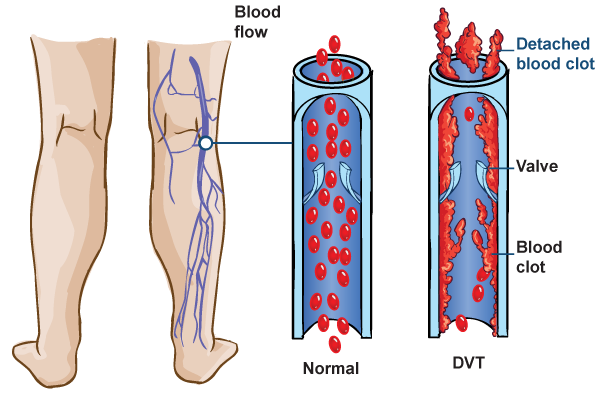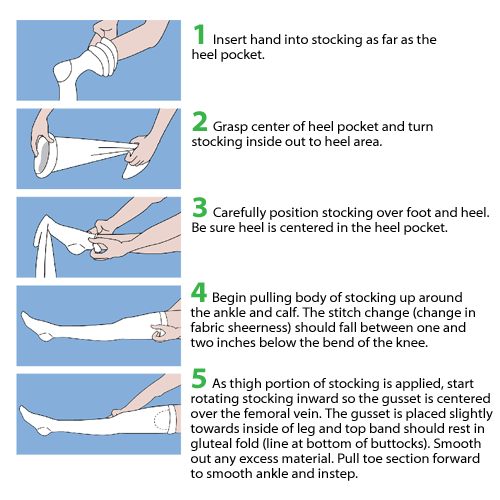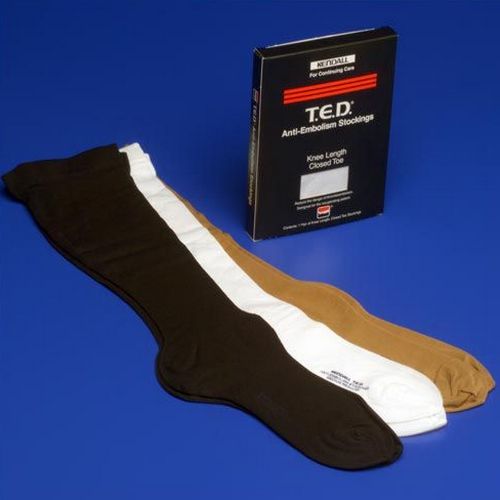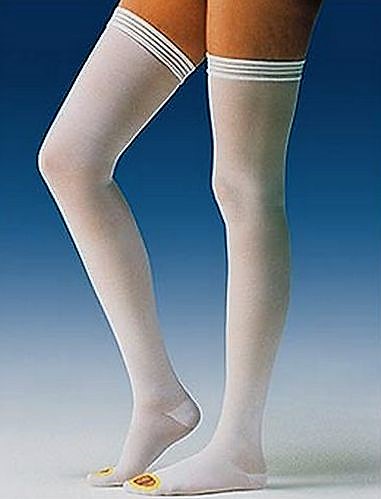What are TED Hose and Stockings?
What are T.E.D. Anti-Embolism Stockings?
T.E.D. stockings, short for thromboembolism-deterrent stockings, are medical compression garments designed to help prevent blood clots (thromboembolism) in patients who are recovering from surgery, confined to bed, or otherwise immobile. By applying gentle, graduated pressure to the legs, these stockings promote healthy blood flow back toward the heart, prevent blood from pooling in the veins, and support lymphatic drainage.
When you’re non-ambulatory, this compression works together with the natural muscle pump action of your calves to keep blood and lymph fluid circulating properly. T.E.D. stockings are available in knee-high and thigh-high lengths, and your doctor can recommend which type is best during your hospital stay and recovery. Because blood clot risk can continue for up to six weeks after surgery or prolonged bed rest, many patients are advised to keep wearing T.E.D. stockings after leaving the hospital.
Like all compression garments, T.E.D. stockings must be properly sized to work effectively. Accurate measurements are essential to ensure the correct fit and consistent compression—consulting a compression stockings and socks buyer’s guide can help you measure correctly.
Are T.E.D. Stockings the same as T.E.D. Hose?
Yes — T.E.D. stockings and T.E.D. hose are the same type of medical compression garment. The terms are often used interchangeably in hospitals, on packaging, and even within the same product listings. In general, “stockings” typically refer to knee-high versions, while “hose” often describes thigh-high styles. However, this distinction isn’t always consistent, so it’s best to check the product description carefully before purchasing to make sure you’re getting the correct length and compression type for your needs.
The most important part of the name is “T.E.D.”, which ensures you’re selecting true anti-embolism compression garments designed to prevent blood clots in non-ambulatory or post-surgical patients. Whether they’re made by Covidien, Jobst, or another manufacturer, the function and purpose remain the same.
What Compression Level are T.E.D. Stockings and Hose?
.png)
T.E.D. anti-embolism stockings and hose work differently from traditional compression stockings or socks. They apply graduated compression, meaning the pressure is strongest at the ankle and gradually decreases up the leg. This gradient encourages blood to flow upward toward the heart, helping prevent blood from pooling in the lower legs—a key factor in reducing the risk of clot formation.
You can expect approximately 18 mmHg of pressure at the ankle, 14 mmHg at the calf, 10 mmHg at the lower thigh, and about 8 mmHg at the upper thigh. This specific compression pattern promotes healthy circulation and supports the veins and lymphatic system while you’re inactive.
T.E.D. hose are intended for use during recovery or periods of limited mobility, such as after surgery, illness, or an extended hospital stay. They’re not meant for everyday use or active wear. For regular daily compression, choose standard compression socks or stockings, which offer higher pressure levels for people who are standing, walking, or on their feet throughout the day.
Key Benefits of T.E.D. Hose:
- Promotes healthy blood flow back to the heart
- Reduces the risk of deep vein thrombosis (DVT) and blood clots
- Helps decrease swelling and leg discomfort during recovery
What is Deep Vein Thrombosis (DVT)?

Deep Vein Thrombosis, commonly referred to as "DVT", is when a blood clot forms in the deep veins of the body. Generally, the blood clot forms in the deep veins of the leg. Deep Vein Thrombosis can cause leg pain or swelling, but sometimes DVT causes no symptoms at all. Deep Vein Thrombosis is a serious medical condition because blood clots in your veins can break loose and travel through the bloodstream. The blood clot can become lodged inside your lungs and block blood flow. This is called a pulmonary embolism. Anti-embolism stockings, like T.E.D. hose, are designed to prevent the formation of these blood clots. Deep Vein Thrombosis can be caused by a variety of medical conditions; however, it is commonly caused by being confined to bed or if you are unable to move for long periods of time. This is why you see TED hose being worn by patients in hospitals. Hospitals have their patients wear anti-embolism stockings in order to reduce the risk of Deep Vein Thrombosis or DVT.
Precautions and When Not to Use T.E.D. Hose
While T.E.D. hose are highly effective for preventing blood clots and improving circulation during recovery, they aren’t suitable for everyone. These stockings should never be worn over open wounds, broken skin, or active infections, as this can trap moisture and bacteria, delaying healing or worsening the condition. Patients with poor circulation—especially those diagnosed with peripheral arterial disease (PAD)—should avoid using compression garments unless specifically approved by a healthcare provider, as the added pressure could further restrict blood flow.
Individuals with diabetes, severe heart failure, advanced vascular disease, or fragile skin should also speak with their doctor before use to ensure T.E.D. hose are safe and properly fitted. It’s important that the stockings are not too tight, as improper sizing can cause discomfort, skin irritation, or even impede circulation instead of improving it.
Always follow your healthcare provider’s instructions on how long to wear your T.E.D. hose each day and how often they should be removed for skin checks and cleaning. Proper use ensures the stockings remain effective, comfortable, and safe throughout your recovery.
How Do I Care for My T.E.D. Stockings?
The easiest way to care for T.E.D. anti-embolism stockings is to rinse them out with cold water after you take them off each day. After a few days of wear, hand wash them with a gentle cleanser such as Jobst Jolastic Compression Washing Solution, if they become soiled you will need to wash them with the cleanser more often. Removing dirt and oil from them will keep them in top working order. The packaging says you can wash them in cold water in your washing machine. However, I have found that they last longer when they are hand washed. To dry them, hang them or lay them flat. Do not put them in the dryer because it will damage them and shrink and warp the fabric. It is best to have two or three pair of stockings so you can rinse or wash them each time you wear them and still have time for them to dry completely before wearing them again.

.png)

